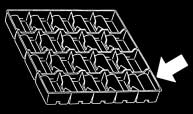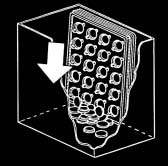Lithium batteries technical handbook


Chapter 6
Avoiding Hazards and Preventing Quality Problems
Avoiding Hazards . 8 9
Preventing Quality Problems . 9 0
Chapter 6






Case Study and Explanation
To store batteries, place each of the batteries in the sections provided on the designated tray in such a way that they
will not make contact with one another.
2,000 new batteries were taken out from the 20-piece
21 cylindrical type lithium batteries with tab terminals
tray containers and thrown randomly into a cardboard
were placed in a 20 piece tray--one battery more than
box where they were stacked on top of one another.
the capacity of the 20-piece tray shown in the figure--
About 30 minutes later, smoke was seen emanating from
two of the batteries were placed together with their poles
the batteries followed by ignition several minutes after
reversed. As a result, the tab terminals came into con-
tact with each other, causing external shorting, and the
Case study: Ignition of batteries stacked together
temperature of the two batteries rose dramatically, gen-
erating heat and causing the halon tubes to burst.
Since two batteries were placed in a space (indicated
by ) allocated to one battery, their terminals made
ing resulted.
This particular case involves batteries which were
packed in trays and destined for OEMs. The batteries
oiding Hazar
oiding Hazar
were packed in an intermediate package consisting of
10 trays with each tray containing 20 (or 40) batteries,
and the trays were stacked on top of each other. The
intermediate package (of the 10 trays) was opened at
ds and Pre
ds and Pre
the distribution stage of our operations, and five of the
trays were delivered to one customer. Since the trays
were stored at an angle inside the box, the batteries fell
venting Quality Pr
venting Quality Pr
out of their positions on
the trays and became
stacked up on the bot-
Generating heat and deterioration of capacity
tom inside the small
box. As a result, some
of the batteries burst.
To store batteries, place each of the batteries in the
sections provided on the designated tray in such a
Case study: Bursting of
way that they will not make contact with one another.
batteries stacked on
top of one another
Chapter 6
Chapter 6
Chapter 6-90
Chapter 6- 93
Preventing Quality Problems
Reduction of Battery Voltage and Deterioration of Capacity
(1) Reduction of battery voltage and deterioration of capacity through contact with antistatic con-
ductive materials
Incidents have been reported where terminal-mounted batteries for memory backup or coin-type lithium batteries
have come into contact with antistatic conductive materials, thus forming external discharge circuits and leading to
voltage drops or capacity deterioration.
In manufacturing plants using ICs, LSI and other semiconductor components, thoroughgoing antistatic measures are
taken. Various protective materials are used to prevent static: most of them have special compounds of carbon,
aluminum foil and other metals and are therefore conductive. These protective materials are used, for example, in the
form of packaging bags, trays, mats, sheets, films, corrugated boards and resin cases.
A protective material may have a resistance ranging from 103 to 106 Ω/cm, for instance. This means that if the (+) and(-) terminals of a battery come into contact with this material, a current ranging from several milliamperes to several
microamperes will flow and the battery will discharge, causing voltage drop and capacity deterioration.
A terminal-mounted battery was inserted into a
A battery was placed directly
Exclusive grounding line
on a rubber sheet spread over
conductive mat. The battery charge was exhausted
a worktable. The (+) and (-)
in several days.
terminals were in contact with
charge was exhausted.
Conductive rubber sheet
When batteries are to be used near protective materi-
Battery-mounted PC boards were inadvertently
brought into contact with spacers and a conductive
als, take every possible care to ensure that the (+) and
oiding Hazar
rubber sheet. The battery
(-) terminals of the batteries or PC boards, etc. on which
charge was exhausted.
batteries are mounted do not touch these protective ma-
terials directly.
ds and Pre
venting Quality Pr
A battery-mounted PC board was inadvertently brought into contact with a conductive resin case. The battery charge was exhausted.
Conductive resin case
Chapter 6
Chapter 6- 93
Chapter 6-91
Preventing Quality Problems
(2) Reduction of battery voltage and deterioration of capacity through contact between batteries
Incidents have been reported where terminal-mounted batteries for memory backup or coin-type lithium batteries
have come into contact each other, thus forming discharge circuits (shorted state) and leading to voltage drops or
capacity deterioration. Observe the following precautions.
1. Remove the batteries from the tray one at a time.
If the tray is turned upside down, the batteries will come into contact with each other, forming discharge circuits.
2. Do not place batteries randomly in a parts box or other container.
Discharge circuits will be formed by multiple batteries coming into contact numbers of the batteries, causing the
batteries to discharge and drain.
Recommended procedures
Prohibited procedures
*Utilize the tray lid in taking out batteries
*Do not throw batteries randomly into a parts box by turning over trays containing batteries.
Intermediate package(200 batteries):20 pieces ✕ 10 trays
Tray containing batteries
Trays containing batteries
Lid tray (tray with no hole)
oiding Hazar
oiding Hazar
ds and Pre
ds and Pre
Discharge circuits
Trays containing batteries
Batteries being exhausted
venting Quality Pr
venting Quality Pr
Battery being exhausted
Battery being exhausted
*Contact of batteries with each other forms discharge
circuits, thus the batteries are drained.
*Lay a tray lid flat and place a tray containing batteries on top of it: batteries are pushed up by protrusions of the lid tray so that they can be easily picked up with fingers.
Chapter 6
Chapter 6
Chapter 6-92
Chapter 6- 93
Preventing Quality Problems
Memory Erasure Problems
<Reference Sample>
Coin-type lithium batteries are often used as the power
supplies for memory backup in various equipment. How-
ever problems with the erasure of valuable data in the
memory due to improper contact between the batteries
and equipment have been reported.
1. When batteries are to be used continuously for a
prolonged period.
Select tab terminal-mounted batteries, and sol-
der the tabs to the battery connection terminals of
the equipment. (See Fig. 1)
When batteries need to be replaced, use a bat-
tery holder (see Fig. 2) or battery with lead wire
connectors (see Fig. 3). Battery holders made by
Panasonic (exclusively for the CR2032 and
BR2032, see Fig. 2) are available for use.
2. When batteries need to be replaced in the short
term, select batteries with no terminals or lead wire
Use of Y-shaped terminals (2-point contact) for
both the (+) and (-) poles as the shape of the con-
nection terminals in the equipment helps to achieve
a more stable contact. (See Fig. 4)
The contact pressure of the contacts should be no
oiding Hazar
less than 2 to 10N (approx. 200 to 1000 gf). (See
To prevent momentary contact failure of several
milliseconds in the circuit, the use of a tantalum
ds and Pre
capacitor, etc. with a capacitance of several micro-
farads is effective. (See Fig. 6)
For the connection terminals of the equipment,
venting Quality Pr
use iron or stainless steel with nickel plating at the
Fig. 5: excessive load
very least. Gold-plating is more suitable when the
contact resistance must be reduced.
Note: Do not touch batteries with bare hands because
perspiration (salt), body oil etc. will increase the sur-
face resistance which may lead to defective contact.
Chapter 6
Chapter 6- 93
Source: http://www.rafborg.is/static/files/Leidbeiningar/Lithium-safety.pdf
Ipca Laboratories Ltd. Executive Summary Village –Sejavta, Tehsil & District–Ratlam (M.P.) EXECUTIVE SUMMARY PROJECT DESCRIPTION GENERAL INTRODUCTION M/s. Ipca Laboratories Ltd. is a reputed name in the Indian Pharmaceutical & healthcare industry. It is a public limited organization engaged in manufacturing
Introduction: NiskayunaCSDMeds is an international mail order option provided through CanaRx for all eligible Employees, Retirees and qualifying Dependents of the Niskayuna Central School District, Niskayuna, New York. For your convenience, a list of eligible medications is located on the back of this page. Copayments: All member copayments have been waived for this program only. NiskayunaCSDMeds Vs. Current local purchase plan








